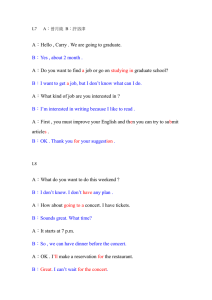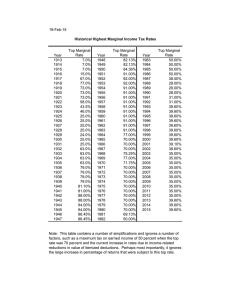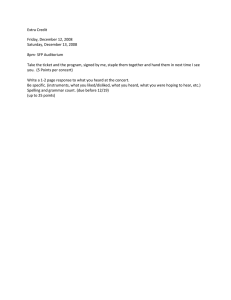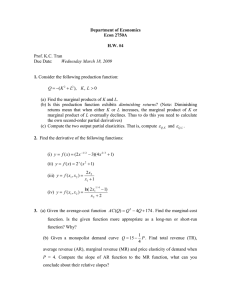Economics Problem Set: Opportunity Cost & Decision Making
advertisement
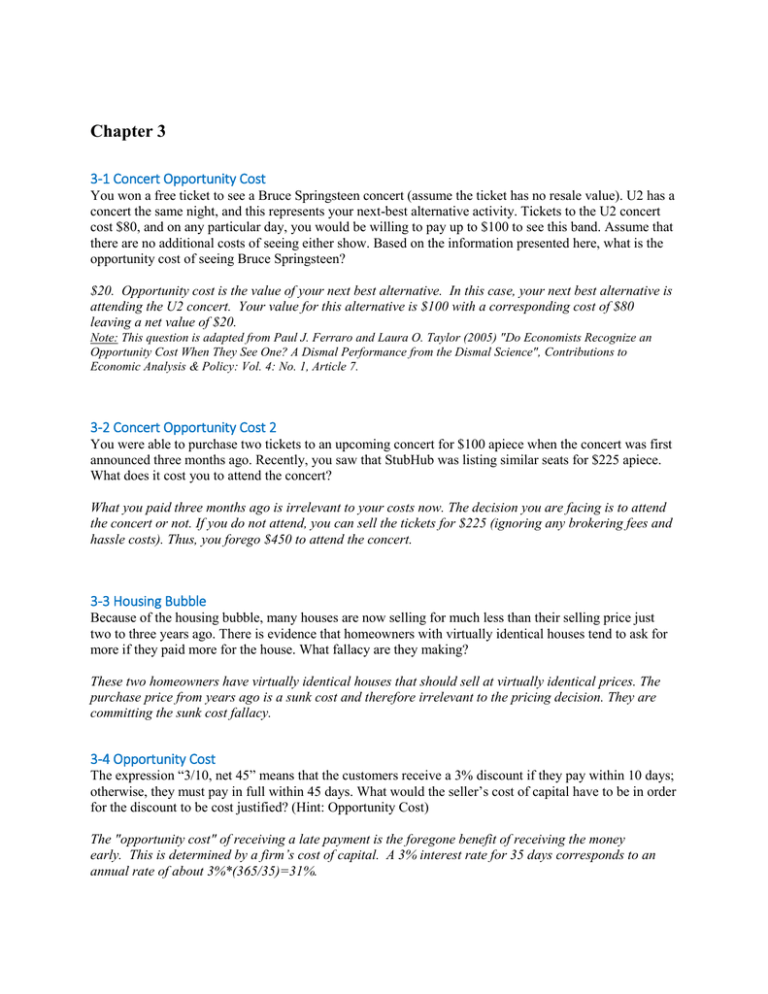
Chapter 3 3-1 Concert Opportunity Cost You won a free ticket to see a Bruce Springsteen concert (assume the ticket has no resale value). U2 has a concert the same night, and this represents your next-best alternative activity. Tickets to the U2 concert cost $80, and on any particular day, you would be willing to pay up to $100 to see this band. Assume that there are no additional costs of seeing either show. Based on the information presented here, what is the opportunity cost of seeing Bruce Springsteen? $20. Opportunity cost is the value of your next best alternative. In this case, your next best alternative is attending the U2 concert. Your value for this alternative is $100 with a corresponding cost of $80 leaving a net value of $20. Note: This question is adapted from Paul J. Ferraro and Laura O. Taylor (2005) "Do Economists Recognize an Opportunity Cost When They See One? A Dismal Performance from the Dismal Science", Contributions to Economic Analysis & Policy: Vol. 4: No. 1, Article 7. 3-2 Concert Opportunity Cost 2 You were able to purchase two tickets to an upcoming concert for $100 apiece when the concert was first announced three months ago. Recently, you saw that StubHub was listing similar seats for $225 apiece. What does it cost you to attend the concert? What you paid three months ago is irrelevant to your costs now. The decision you are facing is to attend the concert or not. If you do not attend, you can sell the tickets for $225 (ignoring any brokering fees and hassle costs). Thus, you forego $450 to attend the concert. 3-3 Housing Bubble Because of the housing bubble, many houses are now selling for much less than their selling price just two to three years ago. There is evidence that homeowners with virtually identical houses tend to ask for more if they paid more for the house. What fallacy are they making? These two homeowners have virtually identical houses that should sell at virtually identical prices. The purchase price from years ago is a sunk cost and therefore irrelevant to the pricing decision. They are committing the sunk cost fallacy. 3-4 Opportunity Cost The expression “3/10, net 45” means that the customers receive a 3% discount if they pay within 10 days; otherwise, they must pay in full within 45 days. What would the seller’s cost of capital have to be in order for the discount to be cost justified? (Hint: Opportunity Cost) The "opportunity cost" of receiving a late payment is the foregone benefit of receiving the money early. This is determined by a firm’s cost of capital. A 3% interest rate for 35 days corresponds to an annual rate of about 3%*(365/35)=31%. 3-5 Starbucks Starbucks is hoping to make use of its excess restaurant capacity in the evenings by experimenting with selling beer and wine. It speculates that the only additional costs are hiring more of the same sort of workers to cover the additional hours and costs of the new line of beverages. What hidden costs might emerge? There could be many hidden costs. Here are a few examples: Some of Starbucks current baristas are underage and are not permitted to serve alcohol. Hiring new bartenders may raise the labor costs. The storage and preparation of cold drinks, like beer and wine, differs considerably from the storage and preparation of hot drinks, like coffee. This suggests two separate “production lines” at each store. The Starbucks brand is known for signaling a quiet, comfy place to linger in small groups or alone. Serving alcohol may change the atmosphere enough that traditional coffee drinkers in the afternoon and early evening will be turned off. The Starbucks brands is also known for high quality coffees that are high quality partly because of the care in choosing beans, roasting them and brewing on the premises. It is not clear that there is much scope for care in 'preparing' beer and wine beverages to add similar value. If not, this brand extension could dilute the signal of the brand. 3-6 Dropping University Courses Students doing poorly in courses often consider dropping the courses. Many universities will offer a refund before a certain date. Should this affect a student’s drop decision? Before this date, the tuition is avoidable. After this date, it is sunk. Before this date, students compare the expected benefits to the tuition cost. After this date, they compare the expected benefits only to avoiding the hassle costs of continuing to participate in the course. Chapter 4 4-1 Extent Versus Discrete Problems Identify which of the following are extent decisions. a. Decide whether to expand an existing product into a new region. Discrete decision. b. What discount should be given on products during the upcoming holiday sale? Extent decision. You must evaluate the marginal increase in sales for each level of discount. Are the profit generated from the price discount greater than the loss from the discount? c. Should the advertising budget be changed for the upcoming year? Extent decision. If the increase in sales (revenue) is greater than the increase in budget (MR>MC), then the budget should be increased. You should also examine how sales would be affected if the budget is decreased. d. Should you develop a new product for an existing product line? Discrete decision. You must decide whether the product should be developed (yes or no). 4-2 Game Day Shuttle Service You run a game day shuttle service for parking services for the local ball club. Your costs for different customer loads are 1: $30, 2: $32, 3: $35, 4: $38, 5: $42, 6: $48, 7: $57, and 8: $68. What are your marginal costs for each customer load level? If you are compensated $10 per ride, what customer load would you want? Marginal Cost is the change in costs due to the additional customer. Since marginal revenue is the price of $10, you will serve customers up to the point where MC > MR or you will serve 7 customers. Q TC 1 30 2 32 3 MC Tot Rev Profit 10 -20 2 20 -12 35 3 30 -5 4 38 3 40 -2 5 42 4 50 8 6 48 6 60 12 7 57 9 70 13 8 68 11 80 12 4-3 Paid for Grades Children in poor neighborhoods have bleak outlooks on life and do not see much gain to studying. A recent experiment is paying children in poor neighborhoods $100 for each “A” they earn in a six-week grade reporting cycle. How does this affect behavior? The amount to study to earn good grades is an extent decision. For most of these children, the marginal costs exceeded the marginal benefits at low levels of effort. With the cash payment, the marginal benefit rises and so they will put in more effort. 4-4 Supplier Bids Your company is contemplating bidding on an RFP (Request For Proposal) for 100,000 units of a specialized part. Why might the amount be more than the requesting company actually wants? It is likely that your chosen supplier will bear some fixed costs to setup for this specialized input and will bear a marginal cost per unit. His bid will be based on his average costs = FC/Q +MC. This is lower if he assumes a larger quantity. If you could get away with making him make this calculation for more than 100,000 units, you might get a lower bid price. 4-5 Processing Insurance Claims Your insurance firm processes claims through its newer, larger high-tech facility and its older, smaller low-tech facility. Each month, the high-tech facility handles 10,000 claims, incurs $100,000 in fixed costs and $100,000 in variable costs. Each month, the low-tech facility handles 2,000 claims, incurs $16,000 in fixed costs and $24,000 in variable costs. If you anticipate a decrease in the number of claims, where will you lay off workers? What costs would be avoided under the two options? The fixed costs at each facility must be incurred (unless the reduction is so big that you can close a facility). Only the variable costs can be avoided. In the high-tech facility, the average variable cost per claim - an approximation of the marginal costs -is $100,000/10,000 = $10 per claim. In the low-tech facility, the average variable cost per claim is $24,000/2,000 = $12 per claim. Therefore, by reducing the work apportioned to the low-tech facility will help you avoid more costs. 4-6 Copier Company A copy company wants to expand production. It currently has 20 workers who share eight copiers. Two months ago, the firm added two copiers, and output increased by 100,000 pages per day. One month ago, they added five workers, and productivity also increased by 50,000 pages per day. Copiers cost about twice as much as workers. Would you recommend they hire another employee or buy another copier? This is an extent decision, so we have to measure the marginal benefit of adding a copier and the marginal benefit of adding a worker. The marginal productivity of a copier is 50,000 pages per day (100,000 pages/2 copiers). The marginal productivity of a worker is 10,000 pages per day (50,000 pages/5 workers). An extra copier will add five times much as an extra worker, but will cost less than five times as much. Buy a copier.






